Multimodal Imaging for Wooden Panel Painting Analysis: Consegna della regola Francescana by Colantonio, a Case Study
Abstract
:1. Introduction
2. Materials and Methods
2.1. Wooden Panel Painting
2.2. SH Technique
2.3. SL3D Scanning Method
2.4. AT Measurement Setup
3. Results
3.1. Surface Information
3.2. Subsurface Information
3.3. Structural Information
4. Discussion and Conclusions
Author Contributions
Funding
Data Availability Statement
Acknowledgments
Conflicts of Interest
References
- Castillejo, M. (Ed.) Lasers in the Conservation of Artworks; CRC Press: Leiden, The Netherlands, 2008. [Google Scholar]
- Paoletti, D.; Schirripa Spagnolo, G.; Facchini, M.; Zanetta, P. Artwork diagnostics with fiber-optic digital speckle pattern interferometry. Appl. Opt. 1993, 32, 6236–6241. [Google Scholar] [CrossRef]
- Groves, R.M.; Osten, W.; Doulgeridis, M.; Kouloumpi, E.; Green, T.; Hackney, S.; Tornari, V. Shearography as part of a multi-functional sensor for the detection of signature features in movable cultural heritaged. In Proceedings of the SPIE 6618, O3A: Optics for Arts, Architecture, and Archaeology, Munich, Germany, 19 July 2007; Volume 661810. [Google Scholar] [CrossRef]
- Asmus, J.F.; Guattari, G.; Lazzarini, L.; Musemeci, G.; Wuerker, R.F. Holography in the conservation of statuary. Stud. Conserv. 1973, 18, 49–63. [Google Scholar] [CrossRef]
- Rossi, M.; Casali, F.; Golovkin, S.V.; Govorun, V.N. Digital radiography using an EBCCD-based imaging device. Appl. Radiat. Isot. 2000, 53, 699–709. [Google Scholar] [CrossRef]
- Dik, J.; Jassens, K.; Van Der Snickt, G.; van der Loeff, L.; Rickers, K.; Cotte, M. Visualization of a lost painting by Vincent van Gogh using synchrotron radiation- based X-ray fluorescence elemental mapping. Anal. Chem. 2008, 80, 6436–6442. [Google Scholar] [CrossRef]
- D’Elia, E.; Buscaglia, P.; Piccirillo, A.; Picollo, M.; Casini, A.; Cucci, C.; Stefani, L.; Romano, F.P.; Caliri, C.; Gulmini, M. Macro X-ray fluorescence and VNIR hyperspectral imaging in the investigation of two panels by Marco d’Oggiono. Microchem. J. 2020, 154, 104541. [Google Scholar] [CrossRef]
- Cavaleri, T.; Pelosi, C.; Caliri, C.; Romano, P.F.; Colantonio, C.; Lanteri, L.; Calabrò, G.; Piccirillo, A.; Ventura, B.; De Blasi, S.; et al. Tracing the history of past treatments: A multi-analytical study of a 16th-century panel painting copy after Raphael. J. Cult. Herit. 2024, 66, 142–154. [Google Scholar] [CrossRef]
- Sfarra, S.; Theodorakeas, P.; Castanedo, C.; Avdelidis, N.; Paoletti, A.; Paoletti, D.; Hrissagis, K.; Bendada, A.; Koui, M.; Maldague, X. Evaluation of defects in panel paintings using infrared, optical and ultrasonic techniques. Insight Non-Destr. Test. Cond. Monit. 2012, 54, 21–27. [Google Scholar] [CrossRef]
- Tornari, V.; Andrianakis, M.; Hatzigiannakis, K.; Kosma, K.; Detalle, V.; Bourguignon, E.; Giovannacci, D.; Brissaud, D. Complementarity of digital holographic speckle pattern interferometry and simulated infrared thermography for Cultural Heritage structural diagnostic research. Int. J. Eng. Res. Sci. (IJOER) 2016, 2, 129–141. [Google Scholar]
- Francis, D.; Tatam, R.P.; Groves, R.M. Shearography technology and applications: A review. Meas. Sci. Technol. 2010, 21, 102001. [Google Scholar] [CrossRef]
- Groves, R.M.; Pradarutti, B.; Kouloumpi, E.; Osten, W.; Notni, G. 2D and 3D Non-Destructive Evaluation of a Wooden Panel Painting Using Shearography and Terahertz Imaging. NDT E Int. 2009, 42, 543–549. [Google Scholar]
- Jončić, N.; Zachar, J. 3D Scanning, in 3D Digital Recording of Archaeological, Architectural and Artistic Heritage; Znanstvena Založba Filozofske Fakultete: Ljubljana, Slovenia, 2017; pp. 23–32. [Google Scholar]
- Saltarelli, C.; Rippa, M.; Pagliarulo, V.; Vigorito, M.R.; Paturzo, M. The Heritage Building Information Modelling System for non-destructive optical techniques: The case study of the restoration of a Marble sculpture on the façade of the Gesù Nuovo Church in Naples. Akta IMECO 2025, 42, 1–8. [Google Scholar]
- Maldague, X.P.V. Introduction to NDT by active infrared thermography. Mater. Eval. 2002, 60, 1060–1073. [Google Scholar]
- Dritsa, V.; Orazi, N.; Yao, Y.; Paoloni, S.; Koui, M.; Sfarra, S. Thermographic Imaging in Cultural Heritage: A Short Review. Sensors 2022, 22, 9076. [Google Scholar] [CrossRef]
- Orazi, N. The study of artistic bronzes by infrared thermography: A review. J. Cult. Herit. 2020, 42, 280–289. [Google Scholar] [CrossRef]
- Vavilov, V.P.; Bison, P.G.; Burleigh, P.G.D.D. Ermanno Grinzato’s contribution to infrared diagnostics and nondestructive testing: In memory of an outstanding researcher. Quant. InfraRed Thermogr. J. 2023, 21, 338–351. [Google Scholar] [CrossRef]
- Paoloni, S.; Orazi, N.; Zammit, U.; Bison, P.; Mercuri, F. A note on the early thermographic approaches for the investigation of the Cultural Heritage. Quant. InfraRed Thermogr. J. 2023, 21, 408–420. [Google Scholar] [CrossRef]
- Rippa, M.; Pagliarulo, V.; Lanzillo, A.; Grilli, M.; Fatigati, G.; Rossi, P.; Cennamo, P.; Trojsi, G.; Ferraro, P.; Mormile, P. Active Thermography for Non-invasive Inspection of an Artwork on Poplar Panel: Novel Approach Using Principal Component Thermography and Absolute Thermal Contrast. J. Nondestruct. Eval. 2021, 40, 21. [Google Scholar] [CrossRef]
- Yao, Y.; Sfarra, S.; Lagüela, S.; Ibarra-Castanedo, C.; Wu, J.Y.; Maldague, X.P.V.; Ambrosini, D. Active thermography testing and data analysis for the state of conservation of panel paintings. Int. J. Therm. Sci. 2018, 126, 143–151. [Google Scholar] [CrossRef]
- Laureti, S.; Colantonio, C.; Burrascano, P.; Melis, M.; Calabrò, G.; Malekmohammadi, H.; Sfarra, S.; Ricci, M.; Pelosi, C. Development of integrated innovative techniques for paintings examination: The case studies of The Resurrection of Christ attributed to Andrea Mantegna and the Crucifixion of Viterbo attributed to Michelangelo’s workshop. J. Cult. Herit. 2019, 40, 1–16. [Google Scholar] [CrossRef]
- Laureti, S.; Sfarra, S.; Malekmohammadi, H.; Burrascano, P.; Hutchins, D.A.; Senni, L.; Silipigni, G.; Maldague, X.P.V.; Ricci, M. The use of pulse-compression thermography for detecting defects in paintings. NDT & E Int. 2018, 98, 147–154. [Google Scholar]
- Di Meo, A.; Balbi, B.; Casciello, M.; Vigorito, M.R.; Mormile, P.; Rippa, M. Complementary infrared imaging methods for the structural and technical analysis of a panel painting: Adoration of the Magi by Marco Cardisco. Infrared Phys. Technol. 2025, 145, 105705. [Google Scholar]
- Rippa, M.; Vigorito, M.R.; Russo, M.R.; Mormile, P.; Trojsi, G. Active Thermography for Non-invasive Inspection of Wall Painting: Novel Approach Based on Thermal Recovery Maps. J. Nondestruct. Eval. 2023, 42, 63. [Google Scholar]
- Rippa, M.; Pagliarulo, V.; Napolitano, F.; Valente, T. Russo: Infrared Imaging Analysis of Green Composite Materials during Inline Quasi-Static Flexural Test: Monitoring by Passive and Active Approaches. Materials 2023, 16, 3081. [Google Scholar]
- Théroux, L.-D.; Dumoulin, J.; Maladague, X. Square Heating Applied to Shearography and Active Infrared Thermography Measurements Coupling: From Feasibility Test in Laboratory to Numerical Study of Pultruded CFRP Plates Glued on Concrete Specimen. Strain 2014, 50, 404–416. [Google Scholar] [CrossRef]
- Hung, Y.Y.; Chen, Y.S.; Ng, S.P.; Liu, L.; Huang, Y.H.; Luk, B.L.; Ip, R.W.L.; Wu, C.M.L.; Chung, P.S. Review and comparison of shearography and active thermography for nondestructive evaluation. Mater. Sci. Eng. 2009, 64, 73–112. [Google Scholar] [CrossRef]
- Sirohi, R. Shearography and its applications—A chronological review. Light Adv. Manuf. 2022, 3, 35–64. [Google Scholar] [CrossRef]
- Scialla, E.; Improda, P.; Brocchieri, J.; Cardinali, M.; Cerasuolo, A.; Rullo, A.; Zezza, A.; Sabbarese, C. Study of ‘Cona degli Ordini’ by Colantonio with IR and XRF Analyses. Heritage 2023, 6, 1785–1803. [Google Scholar] [CrossRef]
- De Vecchi, P.; Cerchiari, E. I Tempi Dell’Arte; Bompiani: Milano, Italy, 1999; Volume 2. [Google Scholar]
- De Castris, P. Museo e Gallerie Nazionali di Capodimonte. Dipinti dal XIII al XVI secolo. In Le Collezioni Borboniche e Post-unitarie; Electa: Napoli, Italy, 1999; pp. 55–57. [Google Scholar]
- Butters, J.N.; Leendertz, J.A. An image-shearing speckle-pattern interferometer for measuring bending moments. J. Phys. E Sci. Instrum. 1973, 6, 1107–1110. [Google Scholar]
- Steinchen, W.; Yang, L. Digital Shearography; SPIE Press: Bellingham, WA, USA, 2001. [Google Scholar]
- Pagliarulo, V.; Lopresto, V.; Langella, A.; Antonucci, V.; Ricciardi, M.R.; Ferraro, P. Non-destructive evaluation of impact damage on carbon fiber laminates: Comparison between ESPI and Shearography. AIP Conf. Proc. 2016, 1740, 040002. [Google Scholar] [CrossRef]
- Tornari, V. A symmetry concept and significance of fringe patterns as a direct diagnostic tool in artwork. Light Adv. Manuf. 2022, 3, 2689–9620. [Google Scholar] [CrossRef]
- Soft Serve Inc. Available online: https://www.softserveinc.com/en-us/blog/structured-light-imaging (accessed on 12 December 2024).
- Maravelakis, E.; Konstantaras, A.; Kritsotaki, A.; Angelakis, D.; Xinogalos, M. Analysing User Needs for a Unified 3D Metadata Recording and Exploitation of Cultural Heritage Monuments System. In Advances in Visual Computing, Lecture Notes in Computer Science; Springer: Berlin/Heidelberg, Germany, 2013; Volume 8034, pp. 138–147. [Google Scholar]
- Artec 3D. Available online: https://www.artec3d.com/it/learning-center (accessed on 11 December 2024).
- Maltese, C. Le Tecniche Artistiche; Mursia: Milano, Italy, 1983; pp. 327–333. [Google Scholar]
- Kosma, K.; Andrianakis, M.; Hatzigiannakis, K.; Tornari, V. Digital holographic interferometry for cultural heritage structural diagnostics: A coherent and a low-coherence optical set-up for the study of a marquetry sample. Strain 2018, 54, e12263. [Google Scholar]
- Chaban, A.; Tornari, V.; Deiana, R.; Andrianakis, M.; Giovannacci, D.; Detalle, V. A combined non-invasive approach to the study of a mosaic model: First laboratory experimental results. J. Imaging 2019, 5, 58. [Google Scholar] [CrossRef]
- Gatto, V.; Anisimov, A.G.; Lettinga, W.; Tao, N.; Lantman, M.; Crijns, B.; Groves, R.M. Application of shearography and thepercussion method for the structural inspection of wall paintings: A case study of St. Christopher in Maria Church, Nisse. In Proceedings of the SPIE11784, Optics for Arts, Architecture, and Archaeology VIII, Online, 21–25 June 2021; Volume 117840K. [Google Scholar] [CrossRef]
- Tao, N.; Anisimov, A.G.; Duijn, E.V.; Vos, L.; Steeman, I.; Keune, K.; Noble, P.; Groves, R.M. Application of shearography with thermal loading for the structural inspection of Rembrandt’s Night Watch. In Proceedings of the SPIE 12620, Optics for Arts, Architecture, and Archaeology (O3A) IX, Online, 9 August 2023; Volume 12620. [Google Scholar] [CrossRef]


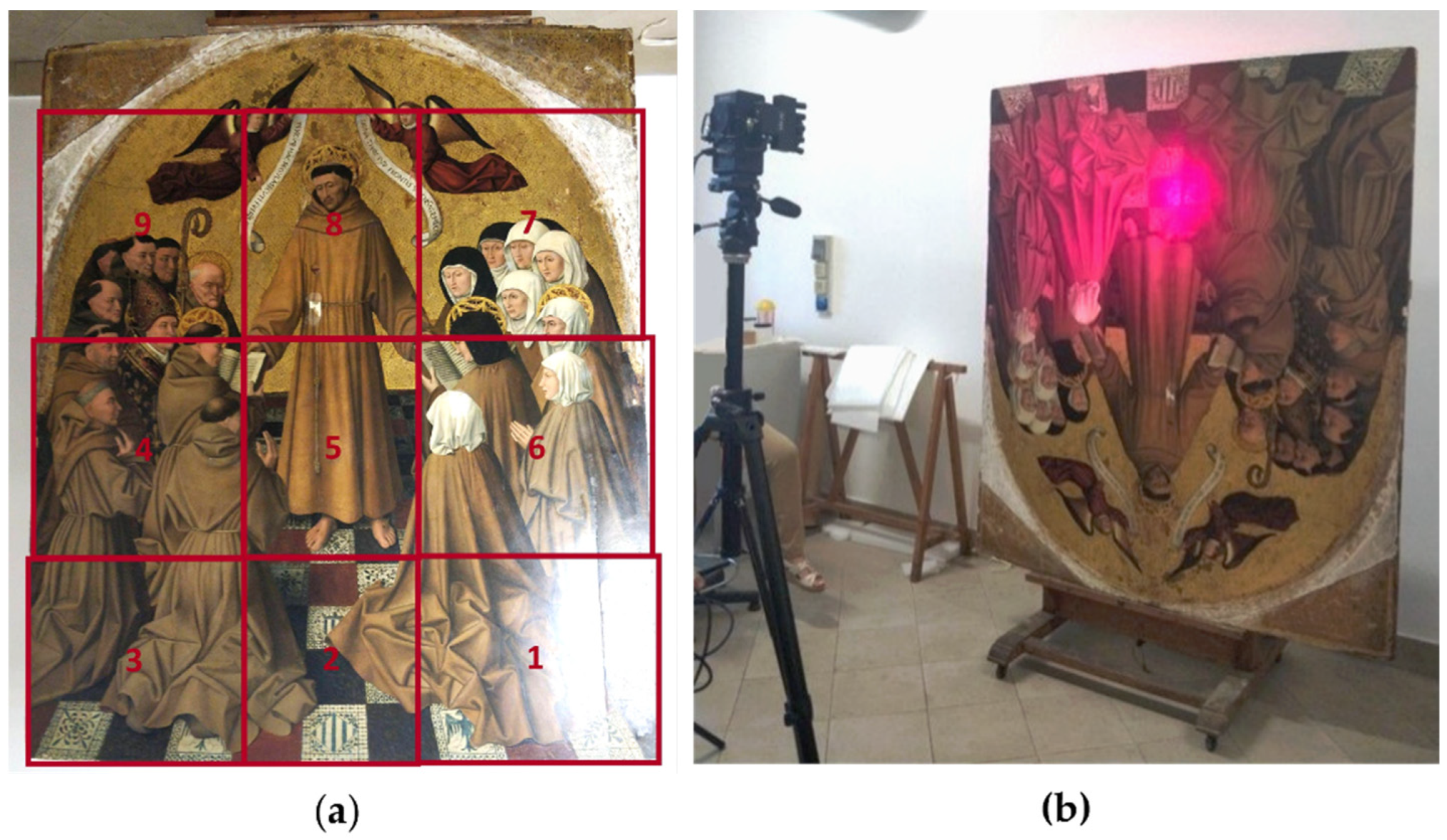


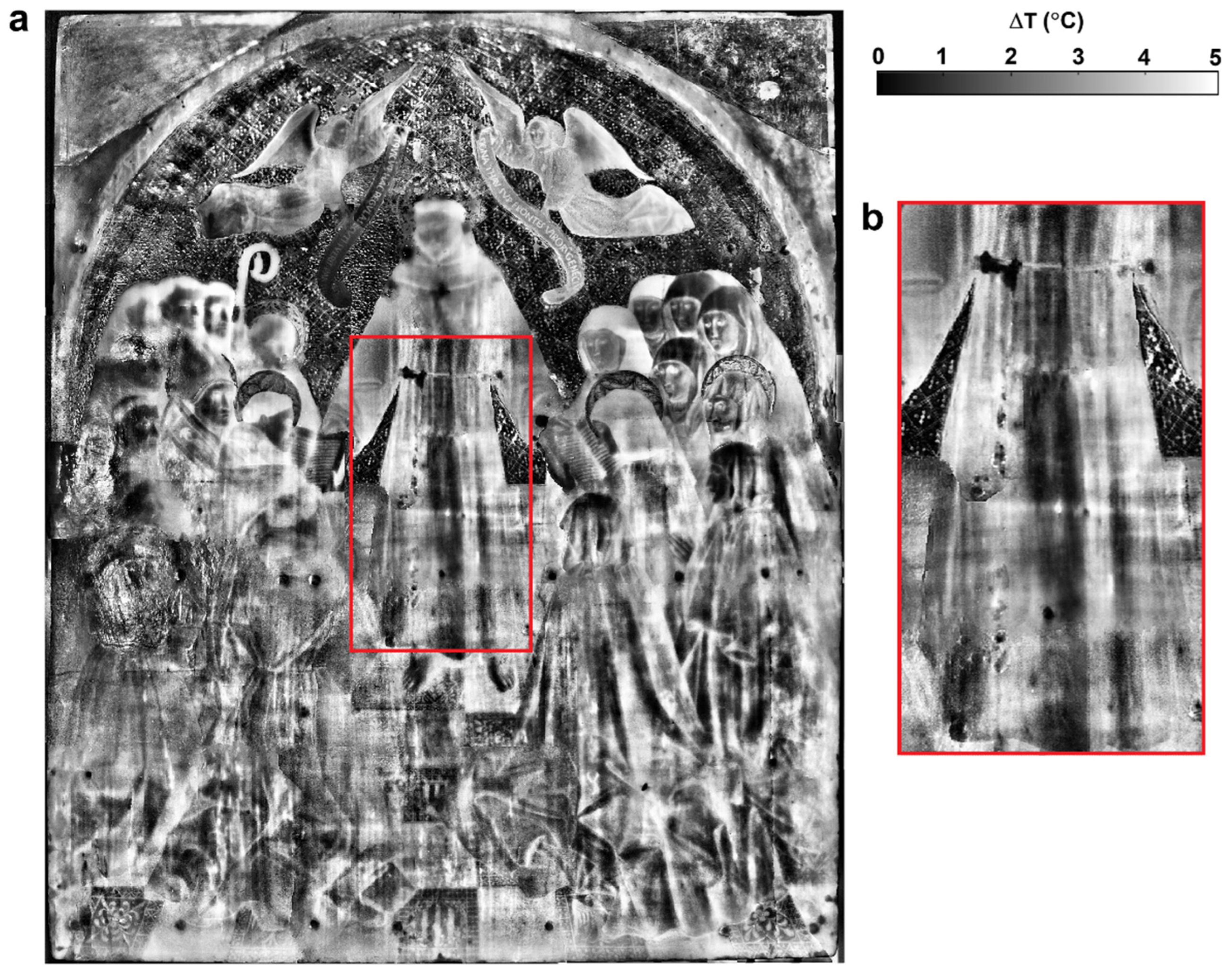
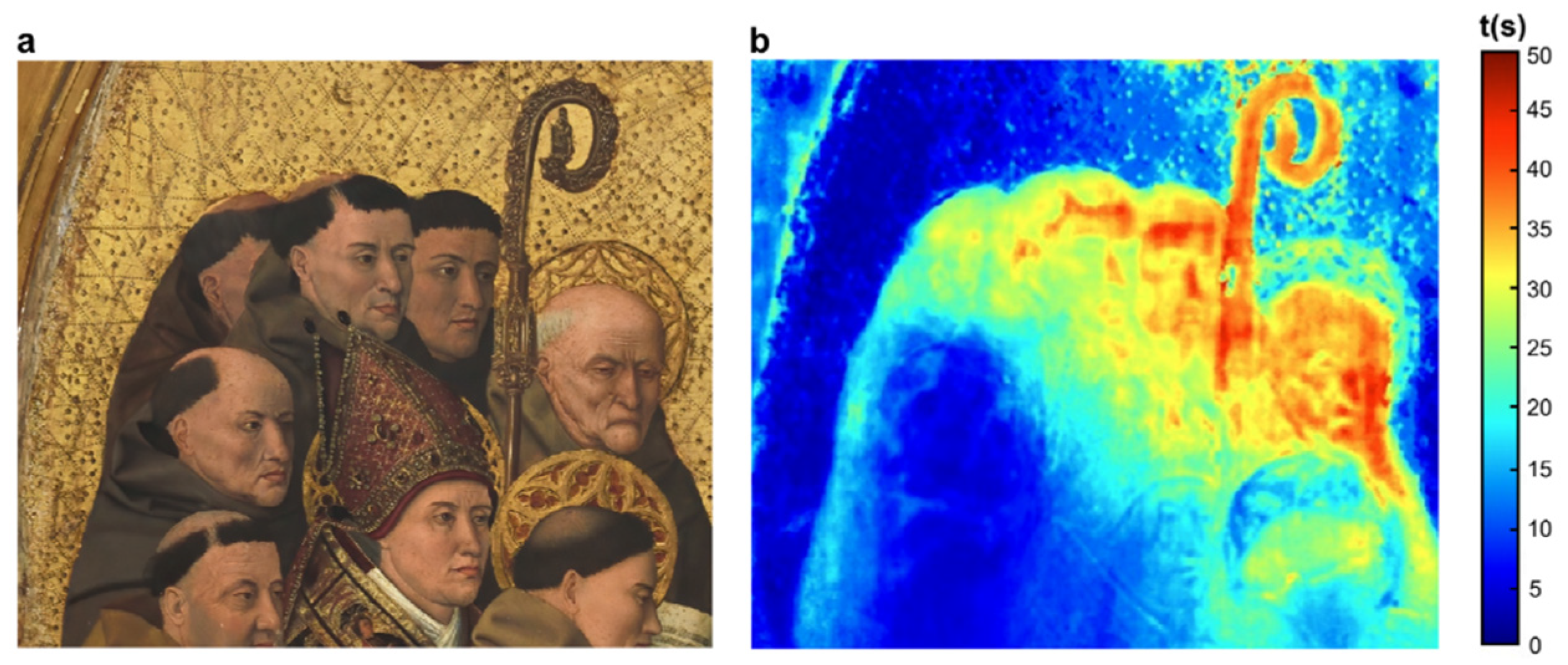

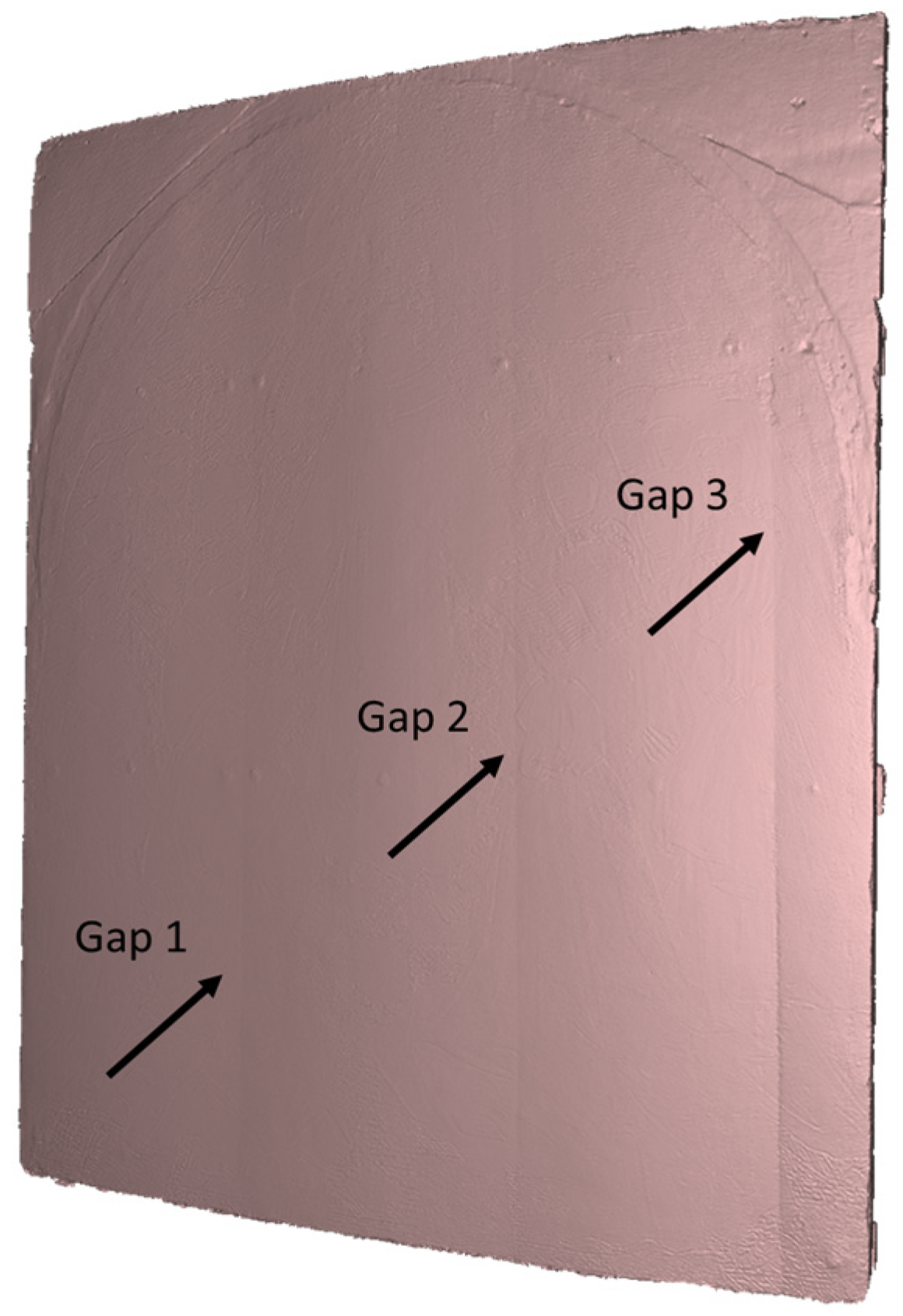
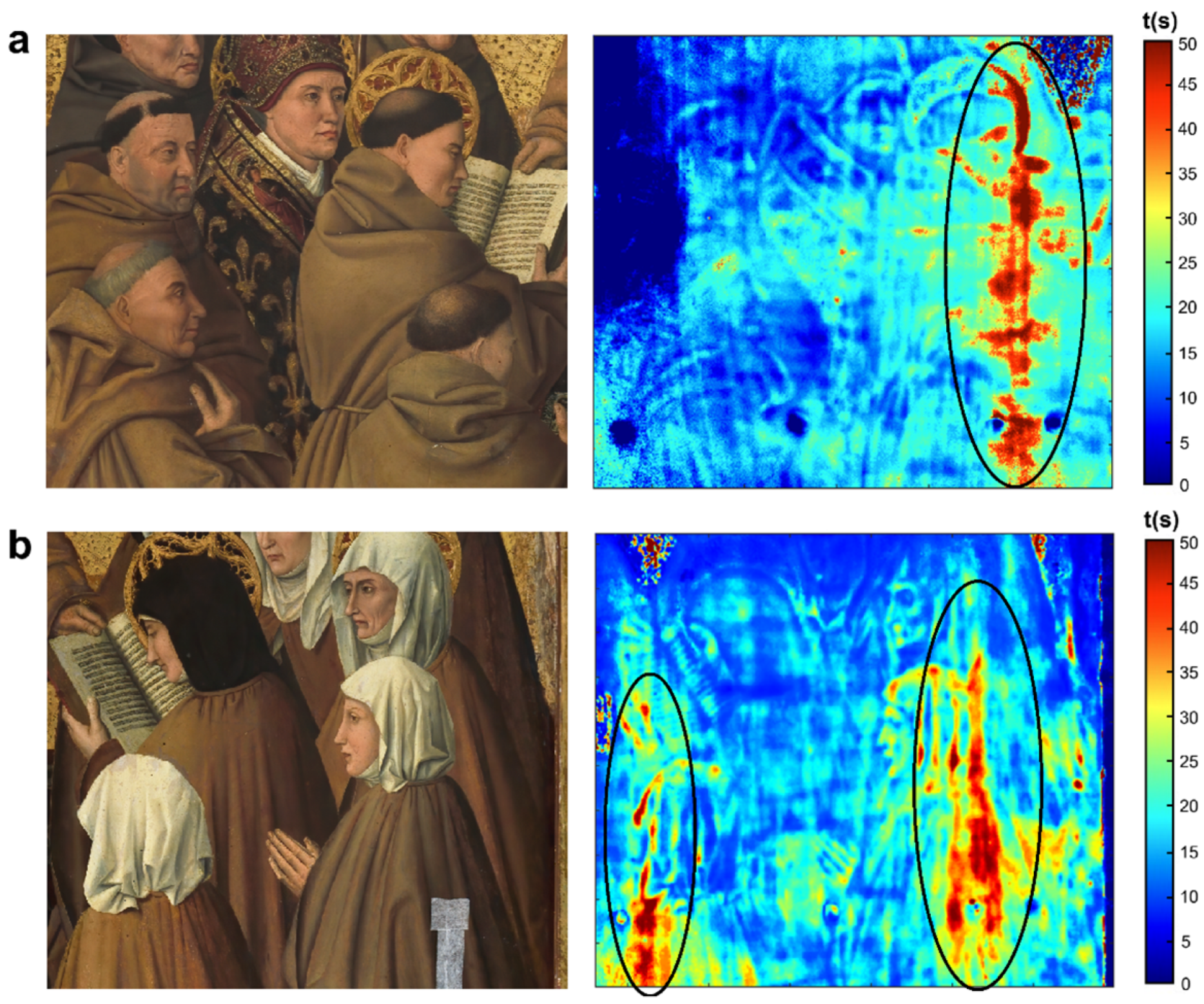

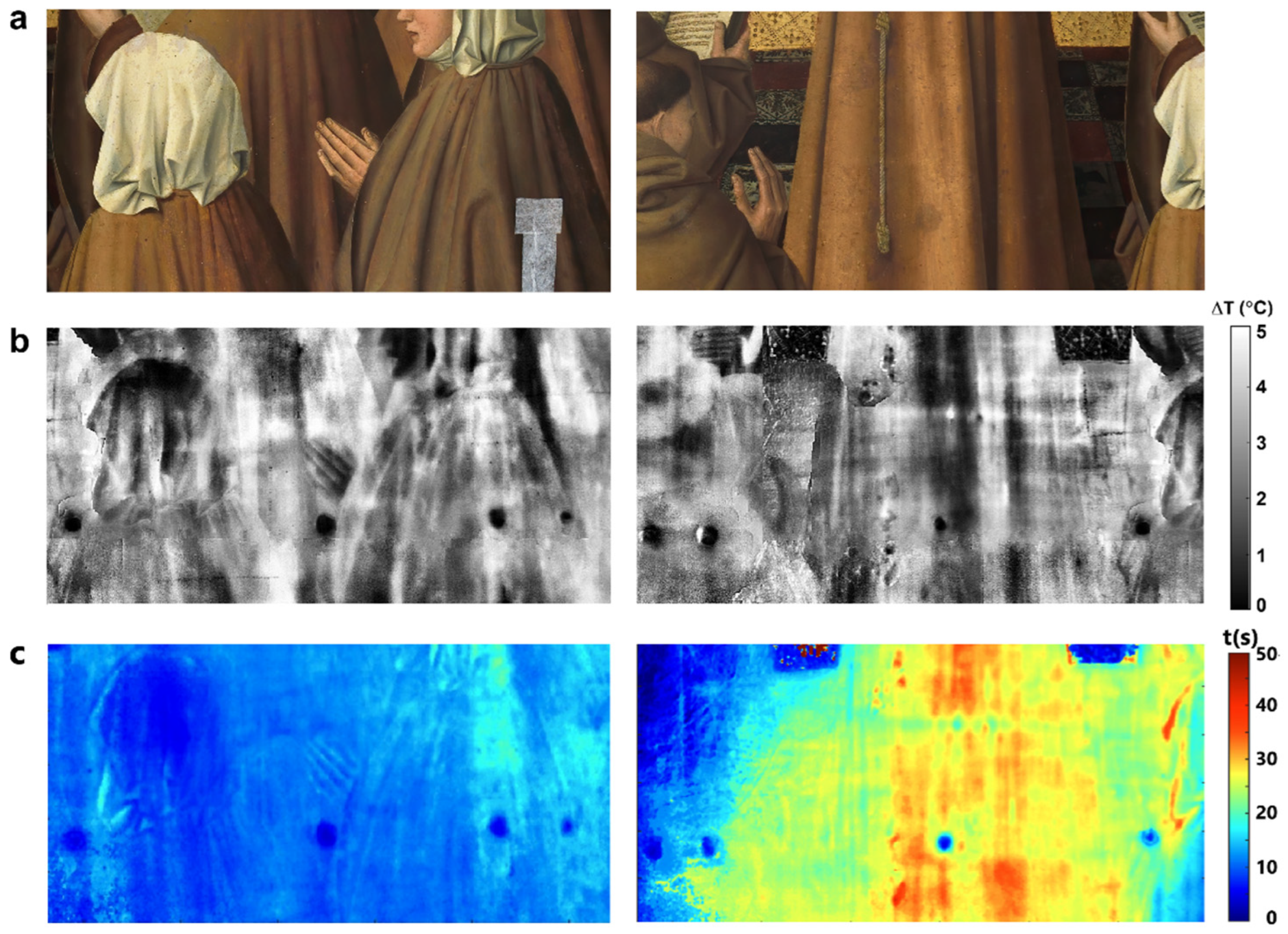
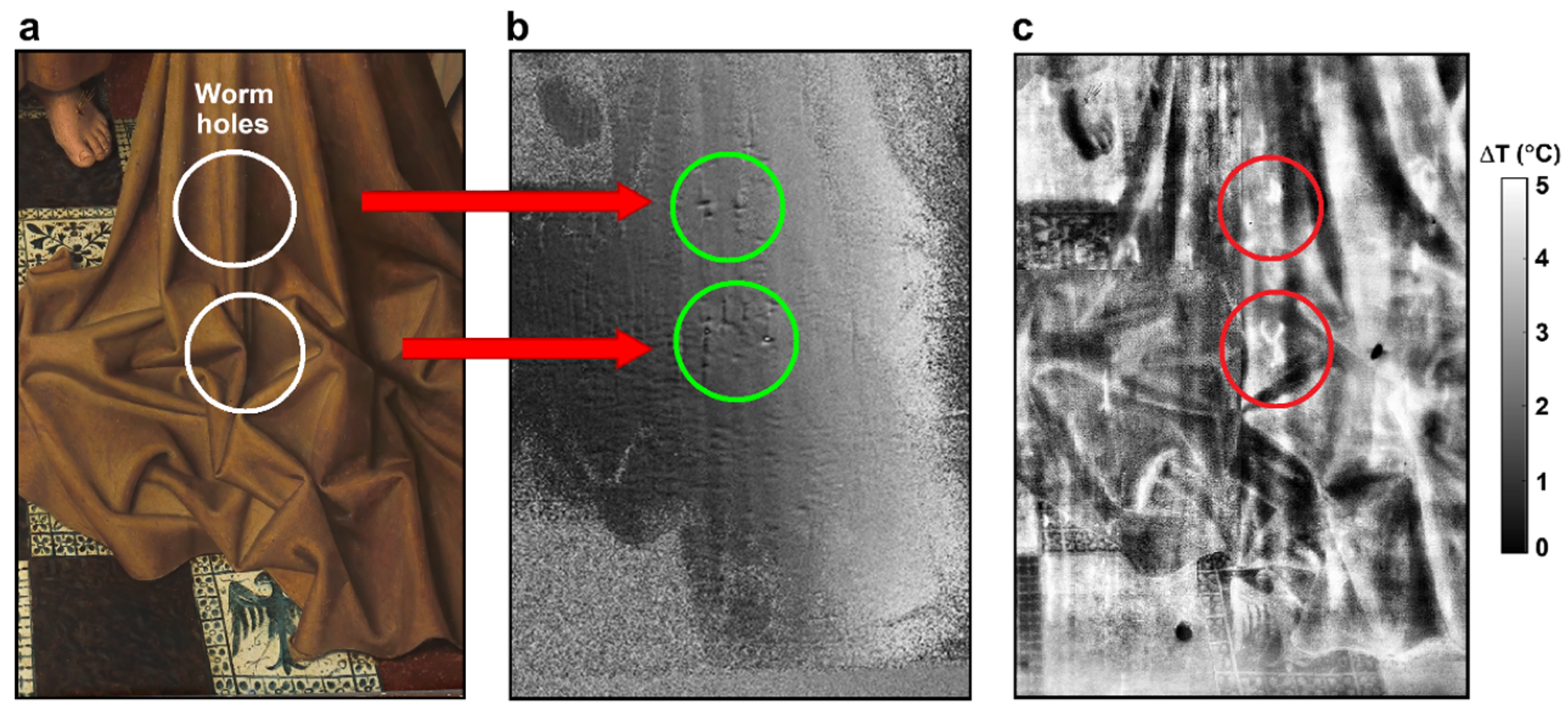
Disclaimer/Publisher’s Note: The statements, opinions and data contained in all publications are solely those of the individual author(s) and contributor(s) and not of MDPI and/or the editor(s). MDPI and/or the editor(s) disclaim responsibility for any injury to people or property resulting from any ideas, methods, instructions or products referred to in the content. |
© 2025 by the authors. Licensee MDPI, Basel, Switzerland. This article is an open access article distributed under the terms and conditions of the Creative Commons Attribution (CC BY) license (https://creativecommons.org/licenses/by/4.0/).
Share and Cite
Saltarelli, C.; Di Meo, A.; Rippa, M.; Pagliarulo, V.; Cacace, T.; Paturzo, M. Multimodal Imaging for Wooden Panel Painting Analysis: Consegna della regola Francescana by Colantonio, a Case Study. Heritage 2025, 8, 118. https://doi.org/10.3390/heritage8040118
Saltarelli C, Di Meo A, Rippa M, Pagliarulo V, Cacace T, Paturzo M. Multimodal Imaging for Wooden Panel Painting Analysis: Consegna della regola Francescana by Colantonio, a Case Study. Heritage. 2025; 8(4):118. https://doi.org/10.3390/heritage8040118
Chicago/Turabian StyleSaltarelli, Chiara, Antimo Di Meo, Massimo Rippa, Vito Pagliarulo, Teresa Cacace, and Melania Paturzo. 2025. "Multimodal Imaging for Wooden Panel Painting Analysis: Consegna della regola Francescana by Colantonio, a Case Study" Heritage 8, no. 4: 118. https://doi.org/10.3390/heritage8040118
APA StyleSaltarelli, C., Di Meo, A., Rippa, M., Pagliarulo, V., Cacace, T., & Paturzo, M. (2025). Multimodal Imaging for Wooden Panel Painting Analysis: Consegna della regola Francescana by Colantonio, a Case Study. Heritage, 8(4), 118. https://doi.org/10.3390/heritage8040118





